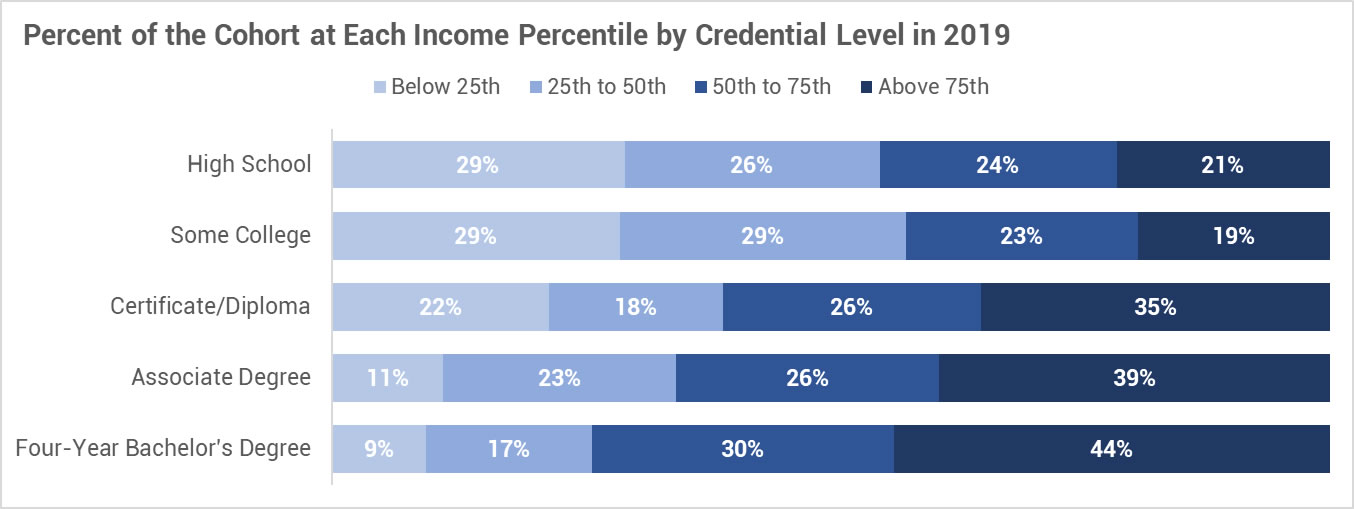CPE report shows that higher education pays for college completers
October 07, 2021

A new Kentucky Council on Postsecondary Education report that tracks Kentucky high school graduates of the Class of 2011 through college and into the workforce shows that higher education pays for those who earn college credentials, even after factoring in college costs and fewer years of full-time work.
The report tracks 43,655 Kentucky students from their high school graduation in 2011 to 2019, the most recent year data is available. It examines cost of attendance, grants and scholarships, net cost, student loan debt, earnings, debt-to-income ratio and economic mobility.
“The evidence is clear, and it’s compelling. Higher education pays for those who earn college credentials in Kentucky, despite a growing narrative that tells us that it’s not worth the time and money.” - CPE President Aaron Thompson
By 2019, eight years after graduating high school, students in the cohort who earned a college credential (36%) were making substantially more than both high school graduates and students who enrolled but left without a credential, despite fewer years of full-time work.
“The evidence is clear, and it’s compelling,” said CPE President Aaron Thompson. “Higher education pays for those who earn college credentials in Kentucky, despite a growing narrative that tells us that it’s not worth the time and money.”
The report found that high school graduates in the cohort earned a median annual salary of $29,478 after eight years in the workforce. By comparison, certificate/diploma holders earned $37,369, associate degree holders earned $38,268, and on-time bachelor’s degree holders earned $41,915 with fewer years of full-time work experience. These differences grow even more pronounced over time.
While the cohort’s economic standing improved at each successive level of education, the report found that nearly 44% of bachelor’s graduates ranked in the highest income percentile--the 75th percentile or above--of Kentucky earners in 2019, compared to only 21% of high school graduates.

Thompson said he hopes the report will help dispel some common misperceptions about college costs and student loan debt that are based on anecdotal information, instead of data. The total net cost of a credential is significantly less than the published sticker price, and the median loan debt of most graduates is affordable.
Financial aid helped lower the median out-of-pocket cost for a credential, significantly increasing affordability. Grants and scholarships covered from 28% to 34% of total college costs for on-time graduates.
In terms of student loans, just over half (53%) of the cohort borrowed to finance their education. On average, the findings show that borrowers in the cohort had a total loan balance of $8,595 for a certificate/diploma, $8,309 for an associate degree, $25,421 for a four-year bachelor’s degree, $32,058 for a five-year bachelor’s degree and $33,688 for a six-year bachelor’s degree.
Corresponding monthly loan payments were about $90 for a certificate/diploma and associate degree, $267 for a four-year bachelor’s degree, $337 for a five-year bachelor’s degree and $352 for a six-year bachelor’s degree.
For the first time, the Council analyzed the debt-to-income ratio to determine if loan debt is reasonably affordable. To calculate the ratio, a student’s total loan debt is divided by annual entry-level earnings. Amounts less than one indicate a reasonable level of debt, while amounts exceeding one suggest a risk of default.
The findings show that for students graduating on time, median loan debt is affordable. The median debt-to-income ratio was 0.43 for a certificate/diploma graduate, 0.33 for an associate graduate, 0.90 for a four-year bachelor’s graduate. Only a five-year bachelor’s graduate and a six-year bachelor’s graduate were above the threshold, at 1.15 and 1.28 respectively. However, as graduates advance in their careers, the debt-to-income ratio becomes more affordable.
While 61% of students in the cohort went to college either in-state or out-of-state, 37% left college before completing a credential or were still enrolled at the end of 2019. Over a quarter of students (26%) in the cohort never enrolled.
The vast majority of completers (70%) from public institutions in Kentucky earned a bachelor’s degree level or above, 18.3% earned an associate degree, 11.8% earned a post-baccalaureate credential and 11.2% earned a certificate or diploma.

“There is no doubt about the economic value of earning a postsecondary credential,” said Dr. Grace Dai, the report’s lead author and researcher. “Higher education not only contributes to students’ upward economic mobility, but it also narrows the wage gap between low-income and non-low-income students.”
The report is available on the Council's website at http://cpe.ky.gov/data/reports/2021roireport.pdf.
Last Updated: 10/12/2021
